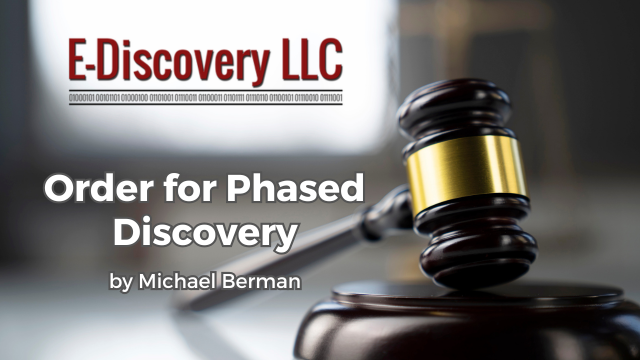
[EDRM Editor’s Note: The opinions and positions are those of Michael Berman.]
Phased discovery is, in my experience, a potentially valuable, but rarely used, cost-saving technique. See Use of Phased Discovery to Achieve Proportionality (Jul. 15, 2022). In appropriate situations, phased discovery can be a useful way to avoid a discovery dispute by “kicking the can down the road.”
Fed.R.Civ.P. 26(f)(3) requires that a “discovery plan must state the parties’ views and proposals on … whether discovery should be conducted in phases….” See also “ESI Protocol” v. “Discovery Plan” (Jan. 2, 2024).
Phased discovery was ordered in Crow v. U.S.A., 2025 WL 2223410, at *4 (D. Id. Aug. 5, 2025). The court wrote: “Plaintiffs filed this action, alleging the IRS violated 26 U.S.C. § 6103 by disclosing their confidential return information….” The IRS asserted that the disclosures were authorized and that damages should be bifurcated from liability. The IRS also asserted that the discovery requested by plaintiffs raised questions of privilege and statutory protections. Id. at *5.
The court wrote:
If a case presents “a potentially dispositive threshold issue,” courts have routinely allowed phased discovery to test the viability of a plaintiff’s individual claims before conducting costly and extensive discovery. Courts have recognized that bifurcated or phased discovery can be an efficient management tool, which can avoid potentially wasteful discovery.”
Id. at *4 (cleaned up and citations omitted; emphasis added).
In Crow, the phasing issue came up in the procedural context of a motion to amend the scheduling order. Id. at *3.
In Crow, the IRS agreed that the governing statute prevented unauthorized disclosures; however, it maintained that statutory exceptions narrowed a taxpayer’s claim for relief. In the court’s words: “The instant record suggests Plaintiffs’ ‘dispositive threshold issue’ is the IRS’s liability under § 7431(b) and its related exceptions.” Id. at *5.
The court wrote that: “Plaintiffs’ outstanding discovery requests relate, in large part, to their claim for punitive damages….” Id. at *5. However, punitive damages were available only if Plaintiffs could show actual damages.
The Crow court wrote:
Because the issues of liability and actual damages are dispositive of Plaintiffs’ claims, phasing discovery to the IRS’s liability under [the good faith exception in] § 7431(b) and its related exceptions would avoid broad and potentially wasteful discovery.
Id. (Emphasis added).
Finding no prejudice to plaintiffs, the court explained: “While Plaintiffs contend ‘more is at issue’ than unlawful disclosure, Plaintiffs do not explain how they could proceed with their punitive damages claims unless the Court rules in their favor on liability.”
The Crow court held that: “The Court will bifurcate this case between the liability and damages phases and requests that both parties submit proposed scheduling orders regarding discovery, dispositive motions, and ADR.”
I have used phased discovery to prioritize custodians. For example, assume hypothetically that plaintiff asserts that there are 10 relevant custodians and discovery from all of them is proportional. Assume that defendant disagrees, and asserts that there are only three appropriate custodians.
A hypothetical phased discovery agreement in a court-approved “discovery plan” could provide for Phase I discovery from the three undisputed relevant, proportional custodians. Or, as a compromise, Phase I might include four or five custodians. If plaintiffs discovered sufficient information, no further custodians would be needed.
However, if plaintiff did not discover sufficient information, it could make a Phase II request for additional custodians. And, that request could perhaps be more focused in light of the prior discovery. Further, in Phase II, defendant would reserve all rights to oppose plaintiff’s Phase II request.
In short, by kicking the can down the road, phased discovery may save money. The only down side is that it may extend the time frame for completion of discovery. And, if the phasing process was submitted to the court for approval in a discovery plan, it would not run afoul of a scheduling order.
In short, by kicking the can down the road, phased discovery may save money. The only down side is that it may extend the time frame for completion of discovery. And, if the phasing process was submitted to the court for approval in a discovery plan, it would not run afoul of a scheduling order.
Michael Berman.
While the hypothetical suggested a possible phasing of custodians, in Guzman v. KP StoneyMill, Inc., 2022 WL 1748308 (D. Md. May 31, 2022), temporal phasing was used. Plaintiff requested discovery for a five year period. Defendant objected. The Court wrote: “Accordingly, I will begin by ordering the production of two years of journals – November 1, 2018 to October 30, 2020 – for all employees.”
The [Guzman] Court then established a phased discovery process. After review of those documents, plaintiff was authorized to request up to three years of additional documents, if it filed an expert affidavit explaining the need for them. If plaintiff did so, defendants were ordered to explain specifically, with an affidavit, the “specific burden” this would impose.
This is a classic example of the use of phased discovery to achieve proportionality.
Use of Phased Discovery to Achieve Proportionality (Jul. 15, 2022).
My discovery plan template contains the following proposal:
1. Phased Production:
Discovery may proceed in two phases.
The parties agree that Phase I discovery from plaintiff will involve a date range from __________ to __________, the custodians listed on Appendix A, and a “hit report” on the search terms in Appendix B.
The parties agree that Phase I discovery from defendant will involve a date range from __________ to __________, the custodians listed on Appendix 1, and a “hit report” on the search terms in Appendix 2.
Phase I discovery shall commence on ______________ and conclude no later than _________________.
Either party may request additional discovery in Phase II. The opposing party may agree or object to that Phase II request. Upon objection, and for cause shown to the Court, Phase II discovery shall be provided.
Phasing may not be right for every case and, even when it may be “right,” it needs to be carefully tailored to the case. If discussed in a Rule 26(f) conference, it can be presented to the court for consideration in a discovery plan or ESI Protocol.
Assisted by GAI and LLM Technologies per EDRM GAI and LLM Policy.


